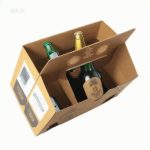In an era where e-commerce and global trade dominate our daily lives, there exists a silent workhorse that makes it all possible: the corrugated shipping box. These unassuming containers are the backbone of logistics, ensuring that everything from life-saving medical supplies to your latest online shopping haul arrives safely and efficiently. Despite their humble appearance, corrugated boxes are marvels of engineering, designed to withstand immense pressure, harsh conditions, and long journeys across continents.
The secret to their durability lies in their unique construction. Corrugated boxes are made from three layers of paper: an inside liner, an outside liner, and a fluted medium sandwiched between them. This fluted layer acts as a cushion, absorbing shocks and providing structural integrity. The result is a lightweight yet incredibly strong container that can protect goods weighing up to several hundred pounds. This design isn’t just about strength; it’s also about sustainability. Corrugated cardboard is one of the most recycled materials on the planet, with recovery rates exceeding 90% in many developed countries.
Beyond their physical properties, corrugated shipping boxes offer unparalleled versatility. They can be customized in countless sizes, shapes, and strengths to meet specific needs. Whether it’s a small box for jewelry or an extra-large container for industrial parts, manufacturers can tailor the dimensions and flute patterns to provide optimal protection. Additionally, these boxes serve as a blank canvas for branding. Companies often print their logos, product information, and handling instructions directly onto the surface, turning a simple shipping container into a powerful marketing tool.
The environmental benefits of corrugated boxes cannot be overstated. Made primarily from renewable resources like trees and recycled paper, they represent a circular economy in action. After serving their primary purpose, these boxes can be broken down and repulped to create new packaging materials, reducing waste and conserving natural resources. Many companies are now investing in even more sustainable practices, such as using water-based inks for printing and optimizing box designs to minimize material usage without compromising strength.
In the context of global supply chains, corrugated shipping boxes play a critical role in cost efficiency. Their lightweight nature helps reduce shipping costs, while their stackability allows for maximized storage and transportation space. Advanced manufacturing techniques have made it possible to produce these boxes at scale quickly and affordably, ensuring that businesses of all sizes can access high-quality packaging solutions. From small artisans shipping handmade goods to multinational corporations moving bulk merchandise, corrugated boxes provide a reliable and economical option.
Looking ahead, innovation continues to drive the evolution of corrugated packaging. Smart packaging technologies, such as embedded sensors that monitor temperature and humidity, are being integrated into corrugated boxes for sensitive shipments like pharmaceuticals and perishable foods. Furthermore, developments in water-resistant and flame-retardant coatings are expanding their applications into previously challenging environments. As e-commerce grows and consumer expectations rise, the humble corrugated box is adapting to meet new demands, proving that even the simplest solutions can have a profound impact on our interconnected world.
In conclusion, while they may often go unnoticed, corrugated shipping boxes are indispensable to modern life. They embody a perfect blend of strength, sustainability, and adaptability, making them an essential component of global commerce. The next time you receive a package, take a moment to appreciate the engineering marvel that is the corrugated box—a true unsung hero of our time.




Leave a Message